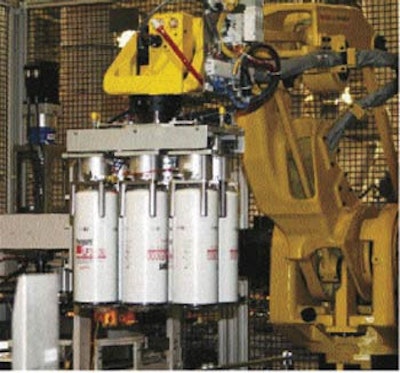It was out with the old, in with the new when New Year’s 2006 rang in with a robotic assist at Cummins Filtration, formerly known as Fleetguard. At its manufacturing operations in Cookeville, TN, a packaging cell employing two robots in a compact, U-shaped line replaced a 30-year old, four-worker operation.
Before, a case erector provided cases that were manually filled and placed on to a takeaway conveyor. Now, two operators man the cell, monitor the system, and replenish the corrugated cases and other supplies as needed.
The first robot packs shrink-wrapped industrial filters into corrugated cases. A second robot then palletizes the cases. Skids are removed from the line by forklift. The robot’s flexibility also permits packaging filters into trays or returnable plastic bins. Operating at least five days weekly over two shifts, the robots are the most tireless of the plant’s 800 workers.
“This is a very important line for the company,” says Phillip Bryant, Cummins’ lead engineer on the project. “It meets our current and future rate requirements.” The line currently packs four to five six-count cases per minute and is capable of doubling that rate. Bryant says the line can handle up to 50 filters per minute.
“The most pleasant surprise has been having very few issues with operation or maintenance, even though this system is complex and completely different from anything else in our plant.”
Nearly all the equipment on the line was provided by Pro Mach (www.promachinc.com), which did the line integration. Its Brenton Engineering Corp. division provided and integrated the two robots from Fanuc Robotics America (www.fanucrobotics.com). Other Pro Mach divisions involved were Wexxar, Belcorp, and ID Technology.
Packaging World reported on this line before, but it was at Pack Expo Las Vegas last fall when the line was set up at Pro Mach’s booth (see packworld.com/go/c162). We wanted to see it in operation in the real world. During the day of our visit, six-count cases were packed, a format that Bryant says is run about 90% of the time.
This line is referred to as a “spin on” line because the threaded filters are spun on by users to install them. It handles 14 different filter heights running from 7.66 inches to 14 inches high and varying in diameter. The filters, which weigh up to about 5 lb each, are shipped globally. About 180 product variations were originally programmed into the system, though the company has reduced the count to 140, Bryant says.
Thus, changeovers are a way of life on the line, Bryant says, and are made primarily during the middle of the week. This is where the robots shine. The menu-driven operator interface that controls most line equipment, including both robots, permits a simple and fast changeover. Typically, the line is changed over in 10 minutes or less, which is about one-half or one-third the time needed on the previous operation.
The line is controlled from an Allen Bradley PanelView Plus 1000 human-machine interface from Rockwell Automation (www.rockwellautomation.com) running Rockwell’s RSLogix 5000 software.
“There’s always that ‘shock and awe’ feeling at the beginning that this thing will never work, but then people adjust and learn the system.”
All the operator must do for a case size change is manually dial in a number using digital wheels on the case conveyor flights; everything else is set through the HMI panel. The plant conducts as many as four or five changeovers a day. “The main interface between the robots and the rest of the cell is easy to understand, and we have been quite happy with it,” says Bryant.
Turned toward robot
Freshly shrink wrapped just upstream, the filters are conveyed through a custom servo-driven turntable from Brenton. It orients alternating filters 180º for case packing for an asymmetric filter that could not otherwise be automatically packed. “It is required for one item,” says Bryant, “but it is a crucial one.” For all others, the filters proceed through unimpeded.
The Wexxar Model 615T Case Erector is equipped with an extended supply magazine that can hold up to 300 blanks, or more than an hour’s worth of production.
The erected cases turn 90º and are conveyed into the cell to the robot in parallel and below the filters, which are singulated in flights and arrive at the Model 420iA (four-axis) Fanuc robot from the opposite direction.
After the robot loads the filters into the cases, the cases proceed on a U-turn conveyor that takes them out of the cell and then back into the cell to the palletizing robot.
For customers that want a corrugated partition, those are inserted manually in a designated space carved out in the layout just outside the cell. “That is only two percent of the output, but it’s that two percent that cripples efficiency,” says Bryant. Nonetheless, they give the customer what they want.
Cases are conveyed through a Belcor Model 252 case sealer and an ID Technology Swing-Arm Tamp Labeler that applies a 4”x6” label to the case side. Before the cases proceed back into the cell to the Fanuc Model 410 case packing robot, they pass by a Little David case coder from Loveshaw (www.loveshaw.com), an ITW Co.
For the pallets, a dedicated supply magazine was selected because the line handles 40” x 40” pallets 90% of the time, Bryant says. There’s also an auxiliary infeed station that accommodates skids up to 48”x48” and other special formats such as returnable plastic containers (RPCs).
Handling RPCs in a range of heights and volumes was one of their biggest debugging challenges, Bryant says. Shipped to companies like John Deere and Komatsu, each company’s RPC is a bit different, some differing by scant inches.
The palletizing robot can also load the filters into trays, especially for work in process. Trays are packed in layers of up to four trays, depending upon the height of the filters.
Slip sheets are added by the robot to the skid ahead of loading. Loads are removed from the line by forklift and unitized on a stretch wrapper about 50 yards away. “We hope some day to have inline stretch wrapping,” says Bryant. Next, though, Cummins will work data acquisition into the line.
Firsts at Cummins
The robotic cell represented two firsts: this was Bryant’s first involvement with a packaging project after six years at Cummins. It was also the first robotic installation for the company. Bryant’s familiarity working with robots at a Nissan automotive plant gave him the confidence on this project.
“The robots have been very robust and have performed well,” says Bryant.
Pro Mach was selected for several reasons, according to Bryant, especially the fact that it provided detailed quotes using AutoCAD and three-dimensional drawings. “Its engineer had great follow-up and answered all questions,” says Bryant. “It was selected from among four different vendors and was by far the most prepared and responsive. We hadn’t worked with Brenton personnel before this, but they were great. By the time it was over, we had a strong relationship with the company. We have completed four other projects with Brenton since this.” Those include an automated gasket supply system on an adjacent line.
“The robotic system has performed progressively better each week, to the point now where downtime is negligible.”
Cummins operators and supervisors spent three days at Brenton for training, brainstorming, and input on this robotic project. That resulted in several changes to the system; for example, log in/log out entry to the interface was added, and the colors on some of the touchscreen menus were changed.
Another change was to add a steel bar over the conveyor rail at the point of forklift access. “We felt this would cause less damage to the rollers when the forklift drivers pick up the load,” says Bryant. “That’s proven to be true.”
In using the footprint of the previous semi-automatic operation, Bryant says the new equipment filled the space edge to edge. In fact, guarding added to protect the rounded end of the U conveyor from forklift traffic actually extends slightly into the aisle. Bryant says they could quickly see that they needed to protect that conveyor from passing forklifts because it was only a matter of time before someone would hit it.
Gets better and better
The robotic system has performed progressively better each week, Bryant reports, to the point now where downtime is negligible. “There’s always that ‘shock and awe’ feeling at the beginning that this thing will never work, but then people adjust and learn the system. We currently have one-to-two percent downtime on the robotic cell, mostly due to set-up requirements or variations in the incoming material. The system has caused very few rejects, and overall the machinery has been easy to work with.
“The most pleasant surprise has been having very few issues with operation or maintenance, even though this system is complex and completely different from anything else in our plant.”
Other Cummins personnel have also been impressed by the line’s performance and success.
“This project has been monitored by our worldwide engineering groups,” says Bryant. “We will find other applications in this facility and around the world where we can utilize this technology.”
To top things off, Bryant himself was also “upgraded.” Since the completion of this project, Bryant has advanced from Six Sigma Black Belt to Master Black Belt level and will oversee future engineering projects of this nature.

































